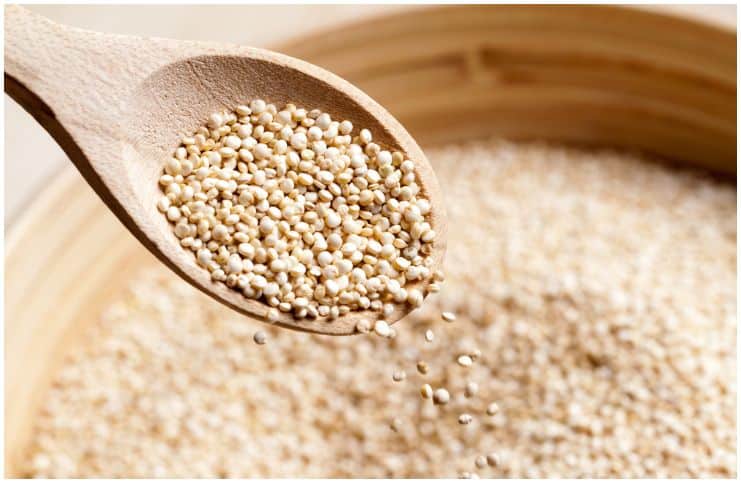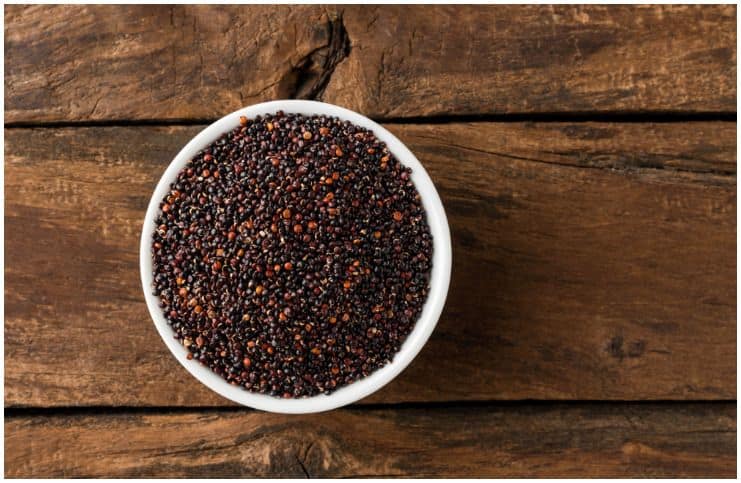This article explains what are the differences between quinoa and couscous.
Benefits And Nutrition Facts Of Couscous
Regular couscous is made from semolina wheat. However, it is also produced from whole-wheat flour, that slightly increases the nutritional value and the fiber content.
It is usually mistaken for a grain, nevertheless, it is the same dough which is made into numerous types of pasta.
Fiber
One cup of cooked couscous has 36 grams of carbohydrates, 176 calories, and 2 grams of dietary fiber.
Fiber can help prevent type 2 diabetes mellitus, heart disease, some types of cancer (especially colon cancer), weight gain and can improve digestive health.
Protein
A 1-cup serving gives you 6 grams of protein, that meets 12 percent of the daily recommended value. Recent research has concluded that a high-protein diet has many benefits for metabolic health and weight loss (especially due to increased satiety).
Selenium
Selenium, an essential mineral, works as a strong antioxidant in the body. Antioxidants are compounds that prevent or slow cell damage by neutralizing free radicals. In addition, eating foods high in selenium has positive antiviral effects, according to studies.
One cup provides 43,2 mcg of selenium, which is 62 percent of the daily recommended value.
Potassium
One of the main benefits of eating foods high in potassium is improved muscle strength and decreased muscle cramping.
Moreover, the ingestion of an adequate amount of this vital mineral will put you at a lower risk of developing heart problems, such as – heart disease and stroke.
One cup has 91.1 mg of potassium, which is three percent of the daily recommended intake.
Manganese
This mineral plays a role in many different chemical processes, including synthesis of nutrients, such as – carbohydrates, cholesterol, and proteins.
However, a deficiency in this mineral is rare, scientists estimate that as many as one-third of the people in the United States do not get the recommended amount of manganese in their daily diet.
1 cup serving has approximately 7 percent of the daily recommended intake of manganese.
Benefits And Nutrition Facts of Quinoa

This pseudo-grain is actually a small seed that is cooked and eaten in a similar manner to most grains.
Fiber
One cup has 5,2g of dietary fiber, which is 21 percent of the daily recommended intake. Fiber is a type of carbohydrate that humans can’t digest.
Whole foods usually contain both insoluble (does not dissolve in water) fiber and soluble (dissolves in water). According to studies, foods high in fiber give a sense of fullness sooner and are more filling than meat and animal-based diet does.
Protein
Your body uses protein to repair and build muscle tissues, as it is an important building block of bones, making the necessary hormones and enzymes, skin, cartilage, and blood.
Additionally, if you’re eating more protein (and fiber), you will be eating less of the junk foods associated with chronic diseases, such as – cardiovascular disease, osteoporosis, gastrointestinal diseases, or diabetes.
1 cup provides 8,1g of protein, which is about 16 percent of the daily recommended intake.
Magnesium
Magnesium, a vital mineral, is needed for the production of RNA, DNA, and proteins, and adenosine triphosphate (the central source of energy in our cells).
This mineral also helps the body to manufacture more IGF-1 – Insulin-like Growth Factor, that is the main contributor to the strength and growth of muscles.
1 cup has 118 mg of magnesium, which is around 30 percent of the recommended daily intake.
Manganese
This mineral is used in many essential enzymes, including glutamine synthetase (plays a key role in the metabolism of nitrogen), arginase, and manganese superoxide.
Furthermore, researchers concluded that a deficiency in this crucial mineral is strongly linked with disorders, like – fertility problems, osteoporosis, poor bone health, diabetes, joint pains, and epilepsy.
1 cup provides 1,2 mg of manganese, which is about 58 percent of the recommended daily intake.
Phosphorus
It is the 2nd most prevalent mineral within the human body. This mineral helps with the proper digestion of niacin (vitamin B3) and riboflavin (vitamin B2) as well as facilitates the transmission of nerve impulses.
More importantly, phosphorus has an important role in how your body repairs cells, use fats, and carbohydrates, stores energy, gives you plentiful and stable energy, and helps your kidneys properly excrete wastes.
1 cup has 281mg of phosphorus, which is around 28 percent of the recommended daily intake.
Copper
Copper is the 3rd most abundant mineral in the human body, however, it must be obtained through certain foods because it cannot be produced by the body itself.
This mineral is vital for glucose and cholesterol metabolism, bone strength, infant growth, iron transport, white and red blood cell maturation, brain development, and heart muscle contraction.
Symptoms of a deficiency in copper include:
- premature gray hair;
- weakness;
- fatigue;
- pale skin;
- frequent sickness;
- sensitivity to told;
- difficulties walking;
- problems with learning and memory;
- brittle and weak bones.
1 cup provides 0.4 mg of copper, which is about 18 percent of the recommended daily intake.
Iron
Iron is an essential mineral for human health. All of our cells contain some amount of his mineral, nevertheless, most of the iron in the body is found in the red blood cells.
Without this mineral, the main cells in the muscles – myoglobin, cannot hold oxygen properly. A deficiency in iron may contribute to disorders, such as – chronic anemia, iron deficiency anemia, cough, and predialysis anemia.
Note – a deficiency in iron should not be confused with an inadequate intake and/or utilization of vitamin B12 (usually due to the absence of intrinsic factor) and folate (vitamin B9).
1 cup has 2.8mg of iron, which is around 15 percent of the recommended daily intake.
Folate
Consumption of foods high in folate is crucial during periods of rapid growth, like – infancy, pregnancy, and adolescence. Moreover, this vitamin is known to encourage the absorption and creation of neurotransmitters.
A deficiency in vitamin B9 can lead to an increased risk of coronary complications, heart disease, and strokes.
1 cup provides 77,7 mcg of folate, which is about 19 percent of the recommended daily intake.
Couscous vs Quinoa – Which Is Better?
They sound alike, they look alike, are frequently mistaken for each other, however, couscous and quinoa are very different indeed.
For example, quinoa has more than double the amount of fiber, which is strongly associated with a faster and healthier weight loss.
In addition, quinoa is a whole food and has a superior nutritional profile. Therefore, we strongly recommend to incorporate quinoa into your regular diet and use couscous sparingly.
References https://www.ncbi.nlm.nih.gov/pubmed/26249220 http://www.telegraph.co.uk/news/science/
